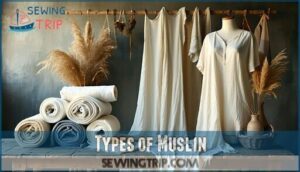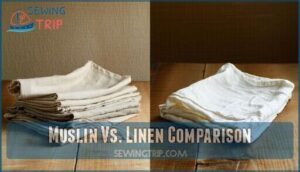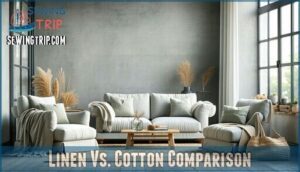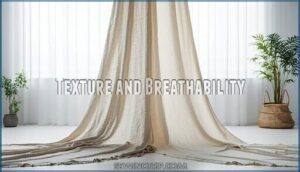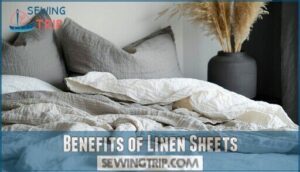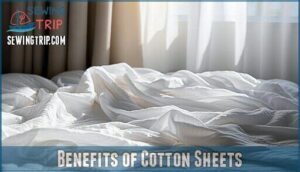This site is supported by our readers. We may earn a commission, at no cost to you, if you purchase through links.
 Looking at the linen vs muslin difference, you’ll find that linen’s made from flax while muslin comes from cotton.
Looking at the linen vs muslin difference, you’ll find that linen’s made from flax while muslin comes from cotton.
Linen’s thicker, more textured, and incredibly durable – it’ll outlast your favorite jeans.
Muslin’s lighter, softer, and has a tighter weave that feels smooth against your skin.
Think of linen as the sturdy workhorse and muslin as the gentle companion.
Both breathe well, but linen’s your go-to for hot summer nights while muslin works year-round.
Price-wise, quality linen costs more upfront but pays dividends in longevity.
The choice between these fabrics depends on what you value most in your home textiles.
Table Of Contents
Key Takeaways
- You’ll find linen’s made from flax fibers while muslin comes from cotton, giving each fabric distinct characteristics – linen’s naturally rougher and more durable, while muslin’s softer and lighter from day one.
- You’re looking at a significant price difference since linen costs more upfront due to labor-intensive flax processing, but it’ll outlast muslin by years, making it better value long-term.
- You’ll stay cooler with linen in hot climates thanks to superior moisture-wicking and breathability, while muslin works better year-round and feels gentler against sensitive skin.
- You can use muslin for delicate projects like baby items, embroidery, and garment testing, while linen excels in heavy-duty applications like upholstery, summer clothing, and kitchen linens that need frequent washing.
Linen Vs. Muslin: Understanding The Differences
When you’re shopping for home textiles, you’ll quickly notice that linen and muslin offer distinct advantages for different needs.
Understanding their key differences in texture, durability, and cost will help you make the right choice for your specific project or room.
Fabric Characteristics
When choosing between these natural fabrics, you’ll notice distinct differences in their fundamental characteristics.
Linen offers superior fiber strength and durability, while muslin provides exceptional softness and drape quality.
Both fabrics feature excellent breathability, though their weave density affects performance differently.
| Characteristic | Linen | Muslin |
|---|---|---|
| Fiber Strength | High durability, long-lasting | Moderate strength, delicate |
| Texture | Coarse initially, softens with use | Naturally soft and smooth |
| Weave Density | Tight weave, structured feel | Loose weave, flowing drape |
| Absorbency Rates | Excellent moisture-wicking | Good absorption, quick-drying |
| Shrink Resistance | Minimal shrinkage when pre-treated | Requires careful handling |
Practical Uses
Understanding texture and breathability helps you choose the right fabric for your specific needs.
Both fabrics excel in different applications around your home.
1. Embroidery Projects – Muslin’s smooth surface accepts thread beautifully, while linen’s texture adds rustic charm.
2. Baby Items – Muslin’s softness makes it perfect for baby blankets and swaddles.
3. Summer Dresses – Linen’s breathability keeps you cool during hot weather.
4. Photography Backdrops – Muslin’s light weight and drape create professional results.
| Application | Muslin Uses | Linen Uses |
|---|---|---|
| Clothing | Lightweight blouses, test garments | Pants, jackets, structured pieces |
| Home Decor | Curtains, quilting backing | Upholstery, table linens |
| Kitchen Uses | Straining liquids, covering dough | Dish towels, napkins |
| Crafting | Embroidery base, pattern making | Wall hangings, decorative items |
| Seasonal Items | Year-round comfort pieces | Hot weather essentials |
Care and Maintenance
Proper fabric care transforms your investment into lasting comfort and beauty. Both linen and muslin thrive with gentle washing techniques using cold water and mild detergent. Skip the harsh chemicals—they’ll damage natural fibers faster than you’d expect.
Smart drying methods preserve fabric integrity. Always hang dry or lay flat rather than using high heat that causes shrinkage and weakening. For ironing tips, use medium heat with a light water spray to prevent scorching and achieve smooth results.
Stain removal works best when tackled immediately. Blot, don’t rub, and rinse with cold water before washing. Storage solutions matter too—keep fabrics in breathable containers away from direct sunlight. Many choose to bleach muslin to achieve a whiter, softer fabric.
| Care Step | Linen Care | Muslin Care |
|---|---|---|
| Washing | Cold water, gentle cycle, no bleach | Cold water, preshrink first use |
| Ironing | High heat with steam | Low heat, steams out wrinkles easily |
| Storage | Breathable containers, avoid direct sun | Fold gently, store in cool, dry place |
Muslin Fabric Details
You’ll discover muslin’s unique qualities that make it perfect for specific home projects. This cotton fabric offers surprising versatility beyond what most homeowners expect.
Types of Muslin
Muslin is like the “Swiss Army knife” of fabrics, offering choices for nearly any project.
With gauze muslin, you’ll notice airy sheerness and a feather-light muslin weave—think baby wraps or gentle kitchen towels.
Swiss muslin stands out for smooth muslin texture and Swiss durability, great for summer wear.
Mull muslin is all about flexibility; bleach and stiffen it for embroidery or delicate linings.
Sheeting muslin’s ruggedness makes it a reliable pick for utility or quilting.
Depending on the project, craft grade muslin is a more affordable option.
Each type reveals its own muslin characteristics, making muslin blends the go-to for creativity, comfort, and reliability.
- Extreme breathability and lightness
- Smooth finish, durable for wearables
- Flexible for embroidery or lining
- Sturdy for quilts or backdrops
Muslin Vs. Linen Comparison
When comparing linen fabric and muslin fabric, you’ll notice distinct differences in fiber source and texture.
Linen comes from flax plants, creating a rougher feel, while muslin derives from cotton, offering exceptional softness.
Fabric weight varies substantially—linen’s denser construction provides superior durability, whereas muslin’s lightweight nature makes it perfect for delicate projects.
Weave density impacts their best uses: linen’s loose weave excels in upholstery and summer clothing, while muslin’s tight weave suits baby items and garment testing.
Cost analysis reveals linen typically costs more due to labor-intensive production, making this fabric comparison essential for budget-conscious projects.
Versatility and Eco-Friendly Options
Choosing sustainable muslin opens doors to countless creative possibilities while protecting our planet.
This versatile fabric offers eco-friendly advantages through responsible production methods. GOTS certification guarantees environmental standards are met.
- Fabric Blends: Organic cotton muslin reduces chemical pesticide use
- Sustainable Sourcing: Ethical suppliers prioritize fair labor practices
- Dyeing Impacts: Natural dyes minimize water pollution compared to synthetic alternatives
- Circularity Potential: Muslin’s biodegradable nature supports waste reduction efforts
Linen Fabric Details
You’ll discover that linen offers unique advantages over cotton and muslin through its distinctive texture and natural properties.
This ancient fabric brings exceptional breathability and hypoallergenic qualities that make it perfect for sensitive skin and warm climates.
Linen Vs. Cotton Comparison
Looking at the stronger fiber strength of linen versus cotton reveals significant differences.
Linen’s flax fibers are thirty percent stronger than cotton’s shorter fibers, creating superior durability. Cotton’s weave density traps moisture longer, while linen’s looser structure promotes breathability.
Water consumption during production favors linen substantially. Dye absorption varies between fabrics.
Cost analysis shows cotton’s affordability, but linen’s longevity provides better long-term value. Linen is also naturally antibacterial, offering better skin health compared to cotton.
Texture and Breathability
Natural fibers create distinct sensory experiences when you run them between your fingers.
Linen’s texture feels crisp and slightly coarse due to its weave density, while muslin’s smooth surface comes from cotton’s softer fibers.
Both fabrics excel at climate comfort through breathability – linen’s moisture wicking properties make it ideal for humid conditions, whereas muslin’s loose weave promotes airflow.
The sensory properties differ substantially: linen maintains structure and coolness against skin, while muslin drapes softly with gentle texture that increases comfort over time, providing climate comfort and a unique sensory experience.
Considerations for Allergies
When dealing with fabric allergens, linen’s natural fibers resist dust mites and bacterial growth better than many alternatives.
Muslin’s weave density affects allergen accumulation substantially. One should also consider breathability for comfort when choosing fabrics.
- Choose certified hypoallergenic fabrics – Look for OEKO-TEX standards to avoid chemical irritants
- Consider dye sensitivity – Unbleached, natural fibers reduce skin reactions
- Check weave density – Tighter weaves trap fewer irritants than loose constructions
Benefits of Linen Sheets
When you’re looking for bedding that keeps you cool and comfortable, linen sheets offer unmatched temperature control that’ll transform your sleep experience.
These natural fiber sheets actively wick moisture away from your body while providing the breathability and durability you need for years of restful nights.
Cooling and Moisture-Wicking Properties
Linen’s hollow fiber structure creates exceptional moisture-wicking performance through natural humidity resistance.
You’ll stay dry as these fibers absorb sweat and release it quickly, maintaining ideal comfort levels.
The loose weave enhances linen breathability, allowing superior airflow for temperature regulation.
For those seeking relief from night sweats, consider linen’s cooling properties.
Unlike denser fabrics, linen’s drying speed keeps you cool throughout the night, making it perfect for hot sleepers seeking better rest.
Linen’s unique properties provide a comfortable sleeping experience, especially with its cooling properties.
Breathability for a Comfortable Sleep
When you slip between linen sheets, you’ll immediately notice how fabric breathability transforms your sleep experience.
The loose weave density allows air to flow freely around your body, creating natural cooling that prevents overheating throughout the night.
Unlike denser fabrics that trap heat and humidity, linen breathability works continuously to regulate your sleep temperature.
This enhanced airflow supports the fabric’s moisture wicking abilities, keeping you dry when you’d normally wake up damp with sweat.
The hypoallergenic properties of linen also contribute to cleaner, fresher bedding that won’t irritate sensitive skin.
You’ll find that linen’s superior breathability compared to muslin breathability makes it the clear winner for hot sleepers.
This cooling effect isn’t just comfort—it’s science working in your favor for deeper, more restorative sleep every night.
Consider purchasing linen breathable sheets for ultimate comfort.
Durability and Longevity
When you invest in linen sheets, you’re choosing fiber strength that outlasts other fabrics.
The dense weave structure and pilling resistance mean your sheets won’t deteriorate quickly. While washing impact remains minimal, linen durability surpasses muslin durability substantially.
Unlike fragile alternatives, linen longevity offers excellent fabric durability with simple repair options available when needed.
For long-lasting quality, consider linen sheet’s resilience, which highlights the durability of linen sheets.
Benefits of Cotton Sheets
When you’re shopping for sheets, cotton offers unmatched smoothness that feels gentle against your skin from day one.
Cotton’s versatility shines through every season, keeping you comfortable whether it’s a chilly winter night or a mild spring evening.
Smoothness and Softness
Cotton sheets wrap you in unmatched comfort with their silky-smooth texture.
Unlike linen’s naturally crisp fabric feel, cotton offers immediate softness that gets better with each wash. This texture comparison reveals why cotton remains popular for bedding.
Here’s what makes cotton’s sensory experience special:
- Instant comfort – No breaking-in period needed like with linen or muslin
- Consistent smoothness – Maintains its soft texture wash after wash
- Gentle on skin – Perfect for sensitive sleepers who need extra care
Cotton’s softness over time actually improves, making it ideal for year-round comfort. Some prefer Pima cotton softness for an even more luxurious feel.
Suitable for All Seasons
You’ll appreciate cotton’s year-round versatility through changing seasons.
Its balanced fabric weight and weave density provide seasonal comfort whether temperatures soar or plummet.
Unlike linen’s cooler focus or muslin’s lightweight nature, cotton offers superior climate adaptability.
Layer blankets during winter for warmth, then strip them away for breathability in summer heat – cotton’s clothing applications work perfectly for all seasons.
Recommendations for Choosing The Right Fabric
When you’re choosing between linen and muslin for your home, consider your budget, intended use, and personal comfort preferences.
Think about whether you prioritize durability and moisture-wicking properties or softness and affordability for your specific project.
High-Quality Brands and Suppliers
You’ll find reliable fabric suppliers by considering brand reputation and ethical sourcing practices.
Leading muslin brands and linen suppliers prioritize sustainable fabrics through transparent manufacturing processes.
Top suppliers worth your consideration include:
- Quince – Offers premium linen sheets with exceptional softness and value
- Brooklinen – Features certified European flax with 155gsm fabric weight
- Cultiver – Uses 100% European flax for superior comfort and drape
- Gross Kobrick Corp – Provides extensive muslin fabric ranges for various applications
These high-quality brands guarantee you’re investing in durable, responsibly-made textiles for your home.
Factors to Consider for Better Sleep Experience
After picking your favorite brands, it’s time to think about what actually helps you sleep soundly.
The right sheet matters—choose bedding with great breathability and temperature regulation, especially if you’re prone to night sweats.
Pay attention to your skin sensitivity and how the linen or muslin feels against your skin.
Some prefer the cool, crisp texture of linen, while others love muslin’s softness.
Think about bedding weight and your sleep environment.
Personal preferences, comfort, and the right fabric will shape every good night’s rest.
Frequently Asked Questions (FAQs)
Is muslin cooler than linen?
Like a gentle breeze versus a crisp wind, muslin’s looser weave makes it feel airier against your skin than linen.
While both fabrics breathe well, muslin’s lighter weight gives it the cooling edge.
Is linen more expensive than muslin?
Yes, linen is generally more expensive than muslin.
You’ll find linen costs substantially more due to its labor-intensive production process from flax plants, while muslin’s cotton manufacturing is simpler and cheaper.
What is the disadvantage of muslin?
Muslin’s main disadvantages include lower durability compared to linen, tendency to fray and fade with frequent use, requires gentler care to prevent degradation, and wrinkles easily requiring careful maintenance.
What is special about muslin fabric?
Cotton’s finest gift to crafters, muslin offers unbeatable softness that improves with every wash.
You’ll love its breathability, affordability, and versatility—perfect for baby items, quilting, garment testing, and photography backdrops.
It dyes beautifully too.
Which fabric works better for baby clothing?
You’ll find muslin works better for baby clothing because it’s exceptionally soft, becomes even softer with washing, offers gentle breathability, and provides the delicate touch babies’ sensitive skin needs.
Can you dye linen and muslin easily?
Picture vibrant threads dancing through fibers like paintbrush strokes on canvas.
You’ll find muslin absorbs dyes beautifully, creating rich colors effortlessly.
Linen takes dye well too, though it requires slightly more preparation for even color saturation.
Whats the price difference between these fabrics?
You’ll typically pay more for linen than muslin. Linen generally costs substantially more due to its labor-intensive production from flax plants, while muslin remains budget-friendly as an accessible cotton fabric.
Which fabric is better for hot climates?
Both linen and muslin excel in hot climates, but linen’s superior moisture-wicking properties and rapid drying make it the better choice. You’ll stay cooler and more comfortable in humid heat.
Do these fabrics cause skin allergies?
Around 2-6% of people experience textile allergies, but you’re likely safe with both fabrics.
Linen’s natural fibers rarely cause reactions, while muslin’s cotton base is generally hypoallergenic and gentle on sensitive skin.
Conclusion
Choosing between these fabrics is like selecting the right tool for each job in your home toolkit.
Understanding the linen vs muslin difference helps you make informed decisions for your specific needs.
Linen offers unmatched durability and cooling properties, making it perfect for hot climates and long-term investment.
Muslin provides versatility and year-round comfort at a more accessible price point.
Consider your climate, budget, and personal preferences when selecting between these quality fabrics for ideal home comfort.
- https://wholesalelinenssupply.com/what-is-the-difference-between-linen-and-muslin/
- https://www.halosleep.com/blogs/aden/what-is-muslin
- https://www.textileschool.com/2632/linen-fiber-from-flax-plants-and-the-linen-fabrics/
- https://textil.best/en/what-is-muslin/interesting-articles/fabrics-materials-and-fillers
- https://fabriclore.com/blogs/fabric-wiki/information-about-muslin-fabric

